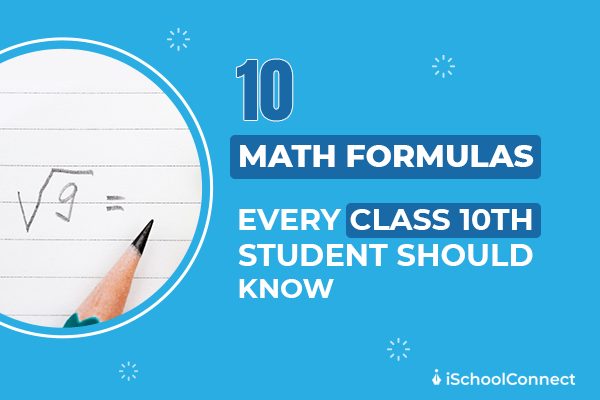Table of Contents
- Math Formulas for class 10 | Ace your exams with these formulas
- Maths formulas for Class 10 All Chapters
- Chapter 1 – Real Numbers
- Chapter 2 – Polynomials
- Chapter 3 – Pair of linear equations in two variables
- Chapter 4 – Algebra & Quadratic Equations
- Chapter 5 – Arithmetic Progressions
- Chapter 6 – Triangles
- Chapter 7 – Coordinate Geometry
- Chapter 8 – Introduction to Trigonometry
- Chapter 9 – Some Applications of Trigonometry
- Chapter 10 – Circles
- Chapter 11 – Areas related to Circles
- Chapter 12 – Surface Areas and Volumes
- Cube formulas
- Chapter 13 – Statistics
- Chapter 14 – Probability
- Key Takeaways
- FAQs
Math Formulas for class 10 | Ace your exams with these formulas
Math Formulas Class 10 is crucial for academic progression and lays the groundwork for advanced math topics in higher studies. These formulas find applications across various fields, including engineering, medicine, business, finance, and computer science.
The formulas taught in class 10 are relevant to almost every industry sector. Topics like real numbers, polynomials, quadratic equations, and geometry of triangles and circles, along with statistics and probability, form the crux of class 10 math. Mastering these formulas is invaluable for students, enabling them to tackle problems more accurately and efficiently.
Learn about: Maths tricks | Tips to acing GRE and GMAT in a few steps
Maths formulas for Class 10 All Chapters
All formulas of class 10 are mentioned below chapter-wise:
Chapter 1 – Real Numbers
Natural Numbers | N ={ 1, 2,3,4,5 … } |
Whole Numbers | W={ 0, 1, 2, 3, 4, 5… } |
Rational Numbers | Those numbers that can be presented as a/b are called Rational Numbers. |
Real Numbers | Real Numbers can be found on a number line |
LCM (P, Q, R) | P.Q.R.H.C.F(P, Q, R) / [HCF ( P, Q) . HCF( Q, R). HCF ( P, R)] |
HCF (P, Q, R) | P.Q.R.L.C.M(P, Q, R) / [LCM ( P, Q). LCM ( Q, R). LCM ( P, R)] |
Chapter 2 – Polynomials
- (a+b)2 = a2+2ab+b2
- (a−b)2=a2−2ab+b2
- (x+a)(x+b) = x2+(a+b)x+ab
- a2−b2 = (a+b)(a−b)
- a3−b3 = (a−b)(a2+ab+b2)
- a3+b3 = (a+b)(a2−ab+b2)
- (a+b)3 = a3+3a2b+3ab2+b3
- (a−b)3 = a3−3a2b+3ab2−b3
Chapter 3 – Pair of linear equations in two variables
Linear equations in one, two, and three variables have the following forms: Linear Equation in one Variable ax + b=0 Where a ≠ 0 and a & b are real numbers Linear Equation in Two Variables ax + by + c = 0 Where a ≠ 0 & b ≠ 0 and a, b & c are real numbers Linear Equation in Three Variables ax + by + cz + d = 0 Where a ≠ 0, b ≠ 0, c ≠ 0 and a, b, c, d are real numbers The pair of linear equations in two variables are given as: a1x+b1+c1=0 and a2x+b2+c2=0 Where a1, b1, c1, & a2, b2, c2 are real numbers & a12+b12 ≠ 0 & a22 + b22 ≠ 0 Quick Note: Linear equations can also be represented in graphical form. |
Chapter 4 – Algebra & Quadratic Equations
To know the algebra formulas for Class 10, first, you must get familiar with Quadratic Equations. The Quadratic Formula: For a quadratic equation px2 + qx + r = 0, the values of x which are the solutions of the equation are given by: Now you know the basic quadratic equation. Let us now go through the list of algebra formulas for Class 10– (a+b ) = a+ b22 + 2ab (a-b)2 = a2 + b2– 2ab (a+b) (a-b) = a2 – b2 (x + a)(x + b) = x2 + (a + b)x + ab (x + a)(x – b) = x2 + (a – b)x – ab (a +b)3 = a3+ b3 + 3ab(a + b) (a-b)3 = a3 – b3 – 3ab(a – b) (x – a)(x + b) = x2 + (b – a)x – ab (x – a)(x – b) = x2 – (a + b)x + ab (x + y +z)2 = x2 + y2 + z2 + 2xy + 2yz + 2xz (x + y – z)2 = x2 + y2 + z2 + 2xy – 2yz – 2xz (x – y + z)2 = x2 + y2 + z2 – 2xy – 2yz + 2xz (x – y – z)2 = x2 + y2 + z2– 2xy + 2yz – 2xz x2 + y2 + z2 – 3xyz = (x + y + z)(x2 + y2 + z2 – xy – yz -xz) y2 + z2 =½ [(x +y)2 + (x – y)2] (x + a) (x + b) (x + c) = x3 + (a + b +c)x2 + (ab + bc + ca)x + abc (x3 + y3= (x + y) (x2 – xy + y2) x3 – y3 = (x – y) (x2 + xy + y2) x2 + y2 + z2 -xy – yz – zx = ½ [(x-y)2 + (y-z)2 + (z-x)2] Quick Note: These formulas will be important in higher classes and various competitive examinations. So, memorize them and understand them well. |
Chapter 5 – Arithmetic Progressions
- The nth term of AP = nth term = a + (n-1) d
- Sum of n terms in AP = Sn = n/2[2a + (n − 1) × d]
- Sum of all terms in AP with the last term ‘l’ = n/2(a + l)
Chapter 6 – Triangles
- A = Area of Triangle
- B = Base of Triangle
- H = Height of a Triangle
- Area of Triangle = A = ½ (b × h) square units
- Area of an Isosceles Triangle = 1/4 b√(4a2 – b2)
- Area of a Right Triangle = A = 1/2 × Base × Height
- Area of an Equilateral Triangle = A = (√3)/4 × side2
Chapter 7 – Coordinate Geometry
- Distance Formula to find distance between two points P(x1,y1) and Q(x2,y2) is = √[(x2 – x1)2 + (y2 – y1)2 ]
- Distance of a point P(x, y) from the origin is = √x2 + y2
- The coordinates of the point P(x, y) which divides the line segment joining the points A(x1 , y1 ) and B(x2 , y2 ) internally in the ratio m1 : m2 = Section Formula = ((m1x2 + m2x1)/m1+ m2 , (m1y2 + m2y1)/m1+ m2)
- The midpoint of the line segment joining the points P(x1, y1) and Q(x2, y2 ) = [(x1+x2/2), (y1+y2/2)
Chapter 8 – Introduction to Trigonometry
The Trigonometry Formulas for Class 10 cover the basic trigonometric functions for a right-angled triangle, i.e., Sine (sin), Cosine (cos), and Tangent (tan), which can be used to derive Cosecant (cos), Secant (sec), and Cotangent (cot). |
The Trigonometric Table comprising the values of these trigonometric functions for standard angles is as follows:
Angle (in Degrees) | 0° | 30° | 45° | 60° | 90° | 180° | 270° | 360° |
Angle (in Radians) | 0 | π/6 | π/4 | π/3 | π/2 | π | 3π/2 | 2π |
Sin | 0 | 1/2 | 1/√2 | √3/2 | 1 | 0 | -1 | 0 |
Cos | 1 | √3/2 | 1/√2 | 1/2 | 0 | -1 | 0 | 1 |
Tan | 0 | 1/√3 | 1 | √3 | ∞ | 0 | ∞ | 0 |
Cot | ∞ | √3 | 1 | 1/√3 | 0 | ∞ | 1 | ∞ |
Sec | 1 | 2/√3 | √2 | 2 | ∞ | -1 | ∞ | 1 |
Cosec | ∞ | 2 | √2 | 2/√3 | 1 | ∞ | -1 | ∞ |
Chapter 9 – Some Applications of Trigonometry
Some other trigonometric formulas are given below– sin (90° – θ) = cos θcos (90° – θ) = sin θtan (90° – θ) = cot θcot (90° – θ) = tan θsec (90° – θ) = cosecθcosec (90° – θ) = sec θ sin2 + cos2 θ = 1sec2 θ = 1 + tan2θ for 0° ≤ θ < 90°Cosec 2θ = 1 + cot2 θ for 0° ≤ θ ≤ 90° |
Chapter 10 – Circles
Circle formulas act as a base for Mensuration. The Class 10 Maths Circle formulas for a circle of radius r are given below: 1. Circumference of the circle = 2 π r2. Area of the circle = π r23. Area of the sector of angle θ = (θ/360) × π r24. Length of an arc of a sector of angle θ = (θ/360) × 2 π r |
Chapter 11 – Areas related to Circles
Area of segment of a circle = Area of the corresponding sector – Area of the corresponding triangle.
Chapter 12 – Surface Areas and Volumes
Sphere formulas
Diameter of a sphere | 2r |
Surface area of a sphere | 4 π r2 |
Volume of Sphere | 4/3 π r3 |
Cylinder formulas
The curved surface area of the Cylinder | 2 πrh |
Area of two circular bases | 2 π r2 |
The total surface area of Cylinder | Circumference of Cylinder + Curved surface area of Cylinder = 2 πrh + 2 π r2 |
Volume of Cylinder | π r2 h |
Cone formulas
The slant height of a cone | l = √(r2 + h2) |
The curved surface area of a cone | πrl |
The total surface area of a cone | πr (l + r) |
Volume of cone | ⅓ π r2 h |
Cuboid formulas
Perimeter of cuboid | 4(l + b +h) |
Length of the longest diagonal of a cuboid | √(l2 + b2 + h2) |
Total surface area of cuboid | 2(l×b + b×h + l×h) |
Volume of Cuboid | l × b × h |
Cube formulas
Perimeter of cube | 12a |
Length of the longest diagonal of a cube | √3a |
The total surface area of a cube | 6a^2 |
Volume of Cube | a^3 |
Chapter 13 – Statistics
(I) The mean of the grouped data can be found by three methods.
Direct Method: x¯=∑i=1nfixi∑i=1nfi
where ∑fi xi is the sum of observations from value i = 1 to n
And ∑fi is the number of observations from value i = 1 to n
Assumed mean method: x¯=a+∑i=1nfidi∑i=1nfi
where a is the assumed mean, and di is a deviation of a from each xi.
Also, di = xi – a
Step deviation method : x¯=a+∑i=1nfiui∑i=1nfi×h
where
- ui=xi−ah
- and h is class size
(II) The mode of grouped data: Mode=l+f1−f02f1−f0−f2×h
l=lower limit of modal class.
h= size of the class interval
f1= frequency of modal class.
f0= frequency of the class preceding the modal class.
f2= frequency of the class succeeding the modal class.
(III) The median for a grouped data: Median=l+n2−cff×h
l=lower limit of median class.
n= number of observations.
cf= cumulative frequency of class preceding the median class.
f= frequency of median class
h= class size
Chapter 14 – Probability
The theoretical (classical) probability of an event E, written as P(E), is defined as
P (E) = Number of outcomes favorable to E / Number of all possible outcomes of the experiment, where we assume that the outcomes of the experiment are equally likely
- The probability of a sure event (or particular event) is 1
- The probability of an impossible event is 0
- The likelihood of an event E is a number P(E) such that 0≤ PE≤ 1
Read more: 30+ Fun maths quiz questions and answers
Key Takeaways
- Due to the massive number of class 10 Math formulas, most students are terrified of mathematics.
- However, mathematics involves more than just memorizing facts from textbooks; it is also about solving and comprehending issues.
- Learning or understanding mathematics formulas is the most effective technique to make this topic enjoyable.
- As a result, mastering math formulae will help kids build confidence and improve their problem-solving abilities.
- Understanding the method behind a specific formula is critical since it aids in memorizing the formulas.
- We all know that practice makes perfect. As a result, constantly solving problems by repeating math formulas for repetition leads to memorization.
- Since our brain remembers what we write regularly, writing math formulas repeatedly might help you recall them longer. So, make a habit of writing down difficult formulas.
We hope you enjoyed reading this blog. In case of any doubts, reach out to us or drop a comment below and share your thoughts.
Like this blog? Read next: The Father of Mathematics | 6 things you need to know about him
FAQs
Ques 1: What is the world’s longest equation?
Answer 1: The Boolean Pythagorean Triples issue was initially introduced in the 1980s by California-based mathematician Ronald Graham. It is the most extended arithmetic equation, according to Sciencealert, and includes roughly 200 gigabytes of text.
Ques 2: How many formulas are there in class 10 math?
Answer 2: Real numbers, polynomials, quadratic equations, triangles, circles, statistics, probability, and other topics are covered in class 10 math formulas.
Ques 3: How do you remember formulas?
Answer 3: You get flawless with practice. When you practice using the formulae, your brain understands and retains the application of the formula. You will notice results if you solve and practice problems by memorizing and applying the formulas.






